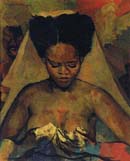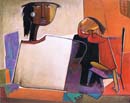In my third time around for The Archivist section, I want on the one hand to piece together some sort of a trilogy of a number of artists who are likened to the advance of the fine arts in the Caribbean and Central America, while on the other hand I want to lay bare the interrelations that many of them wove among themselves, basically in the 1930s and 40s. We read about Costa Rica’s Max Jimenez leaving his footprints in Havana, and about Jaime Colson tutoring Mario Carreño as he endured a weird transformation from Student to Master. But the case of Galicia-born Angel Botello Barros is one of a kind. As a matter of fact, no other artist who lived in exile in the Americas following the Spanish Civil War toured all the islands and nations of the Greater Antilles as he did.
He was born in 1913 in the town of Cangas de Morrazo, Galicia, and passed away in 1987 in Puerto Rico. However, he’s become one of the hottest artists in the auctions held at the Sotheby’s and Christie’s. Nicknamed “the Caribbean Gauguin” for a number of reasons, his artistic formation and itinerary embraced art studies at the École de Beaux Arts in Bordeaux and the San Fernando Academy in Madrid. In 1939, his family migrated to the Dominican Republic. Later on, he traveled to Mexico, Cuba and Haiti, and settled down eventually in Puerto Rico.
I’d like to make a pause in his stay in Cuba because as many bibliographic references set his trip in 1940, the documents I treasure in my archives point he made that journey in 1943 and spent eight months in Havana. In that span of time, he put on a couple of individual exhibitions in the nation’s capital. The first exhibit came down as an invitation from the celebrated Havana Galician Center and opened in the month of May, while the second one took place in October at the Lyceum. The themes of the paintings he exhibited in both locales dealt with the Galician scenery and lifestyle, with Haitians and Dominicans, plus a number of portraits. I don’t know whether he painted in Cuba, but chances are he actually did as he stayed for eight months on the island. There’s no evidence either of any of his artworks in Cuban collections.
Even though the Cuban press provided extensive and positive coverage of his expositions, very little or nothing at all has remained about his visit in the memory of Cuba’s fine arts. Both Dr. Rene Villaverde and Argentine critic Efraim Tomas Bo, praised his works, two catalogs with the listings of his artworks were printed. That leads to believing there’s no reason for this long and absolute oblivion. However, our efforts to ferret out a valid answer without so much deliberation might perhaps help us find the reasons in his own work.
In 1943, Cuba’s artistic ambience was in full swing; the symbolic battle had made academicians and modernists square off, though the balance was tipping to the latter. The so-called “second avant-garde” (Cundo, Mariano, Lozano, Felipe Orlando, Portocarrero) was definitely getting stronger as postimpressionist landscapes and Paul Gauguin-influenced figures began to raise a few eyebrows. Even Victor Manuel, the standard-bearer of the first avant-garde movement, had gotten over those influences. In his entry for the 1943 Cultural Yearbook, Guy Perez Cisneros, the most influential critic at that time, ignored Botello Barros’ presence as he failed to include his name in the “Friendship Hall”, a section that gathered information on foreign painters and sculptors who either visited or exhibited in Havana in that same year. Not even the listing of exhibitions put on at the Lyceum contains a single mention of his works that, according to the catalog, remained open from October 13 thru 26, 1943.
Today, Angel Botello has been assimilated by the Puerto Rican arts. His paintings and sculptures developed from the 1950s onward with a very personal style of his own. The Botello Gallery was set up by the painter’s family and today is one of the most important ones in Puerto Rico’s San Juan. The price tags on many of his artworks are actually very high.
Regardless of the reasons contemporary artists had to downplay his visit to Cuba, I just wanted to dust off his file and pay tribute to one of the artists who enriched the Caribbean arts.


Related Publications

How Harumi Yamaguchi invented the modern woman in Japan
March 16, 2022
Giovanni Duarte and an orchestra capable of everything
August 26, 2020











